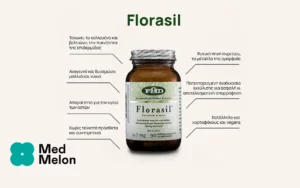Scientific Names:
Serenoa repens (Bartel.) Small [Fam. Arecaceae]
Forms:
Berry extract of saw palmetto.
Traditional Usage:
– Anti-inflammatory
– Benign Prostatic Hyperplasia (BPH)
– Bladder Health Maintenance
– Bronchitis
– Catarrh (mucous)
– Hormonal Imbalances
– Inflammation (non-bacterial of prostate)
– Immune System
– Laryngitis
– Male Health Maintenance
– Prostate Health Maintenance
– Urinary Problems
Overview:
Saw palmetto, Serenoa repens (Bartram) J. K. Small [Fam. Arecaceae], is a small shrubby palm of the sandy soils of the southern USA. The berries have been used as food and medicines by First Nations dating back to pre-contact times with archaeological sites showing their importance to Florida’s pre-Columbian peoples. Indigenous Indians of the southern USA were using saw palmetto berries for treating testicular atrophy, erectile dysfunction and prostate inflammation in the early 1700s. The newest edition of the United States Pharmacopeia and the National Formulary list saw palmetto berries as an accepted botanical medicine. Over twenty successful human studies have been documented on the usefulness of saw palmetto berry extract for treating benign prostatic hyperplasia or BPH. An excellent review of 18 randomized controlled trials for treating BPH involving 2939 men concluded that saw palmetto improves urologic symptoms and flow measures. Saw palmetto produced improvement in symptoms and urinary flow similar to Finasteride, the most common synthetic pharmaceutical drug prescribed for treating BPH, and has fewer side effects. Saw palmetto berries were listed in the 19th Edition of the US Dispensatory for treating chronic and subacute cystitis, chronic bronchitis, laryngitis, catarrh and enlarged prostate, while the 23rd edition stressed their usefulness for treating, “the enlarged prostate of old men”. The Extra Pharmacopoeia of Great Britain and the British Pharmaceutical Codex list saw palmetto for treating cystitis, chronic bronchitis and for the stimulation of the genitourinary tract and mucous membranes. Many herbal preparations used for prostate conditions are also used for kidney, bladder, and urethral conditions that affect urination in men. The available data on saw palmetto document that the liposterolic extracts possess anti-androgenic activity and prove beneficial in the treatment of benign prostatic hyperplasia. In addition, the extracts possess anti-inflammatory and immunostimulant activity based on in-vitro and in-vivo studies.
Active Ingredients:
The main constituents of saw palmetto berries include free fatty acids and sterols. The components of saw palmetto that have received most attention are the lipids. The oil is made up of triacylglycerols of fatty acids with chain lengths usually less than 14 carbons and predominantly with lauric acid followed by myristic and oleic acids. The berries also contain flavonoids, terpenoids, and polysaccharides. There are remarkably no unusual alkanes, alkenes, polyprenols, sterols or free fatty acids in the non-polar extracts. b-Sitosterol is the major sterol found in the fruit. Variation in the liposterol content of the fruit, and other possible active ingredients, based on phenological patterns of the plant and geographical location of collections has yet to be reported. Solvents used for extraction of the liposterols include ethanol, hexane or supercritical CO2. The fruit also contains a lipase that remains active in the berries during ripening and drying resulting in a rancid odor and taste. Methyl and ethyl esters of free fatty acids also contribute to the characteristic aroma of the herbal drug.
Suggested Amount:
Extract: 160 mg two times per day (total 320 mg).
Capsules: One 585 mg capsule up to three times per day.
Tincture (1:2 liquid extract) 20 to 30 drops up to four times per day.
Symptoms should improve in 30 to 90 days. Usually taken for four to six months.
Drug Interactions:
None known.
Contraindications:
None known. Note: Many of the symptoms of BPH are similar to the symptoms of prostate cancer. Consult a physician for a proper diagnosis. Consult a physician if symptoms are accompanied by pain or fever as this may indicate a bacterial infection. Due to lack of safety data, saw palmetto is not recommended during pregnancy or lactation.
Side Effects:
Saw palmetto extracts have been well tolerated in clinical studies and only one withdrawal from a study has been reported in the literature, due to gastrointestinal upset. Data synthesis of 18 randomized, controlled trials involving 2939 men concluded that adverse effects due to saw palmetto were generally mild and comparable with placebo. Take with meals to avoid stomach upset.
References:
Bennett, B.C. and J.R. Hicklin. 1998. “Uses of saw palmetto (Serenoa repens, Arecaceae) in Florida,” Economic Botany, 52(4): 381-393.
Diamond, S. and G.H.N. Towers 2000. Valerian, Saw Palmetto and Goldenseal.
In: Mazza, G. and D.B. Oomah, eds. 1999. Herbs, Botanicals and Teas as Functional Foods and Nutraceuticals. Techomic Publishing Inc., Lancaster, PA, USA. Chapter 7.
Gerber, G.S., G.P. Zagaja, G.T. Bales, G.W. Chodak and B.A. Contrenas. 1998. “Saw palmetto (Serenoa repens) in men with lower urinary tract symptoms: effects on urodynamic parameters and voiding symptoms,” Urology 51(6): 1003-1007.
Newall CA, Anderson LA, and Phillipson JD. 1996. Saw Palmetto in Herbal Medicines. A Guide for Health Care Professionals. The Pharmaceutical Press, London, pp. 237-238.
Wilt, T.J., A. Ishani, G. Stark, R. MacDonald, J. Lau and C. Mulrow. 1998. “Saw palmetto extracts for treatment of benign prostatic hyperplasia. A systematic review,” JAMA 280 (18): 1604-1609.




